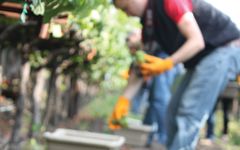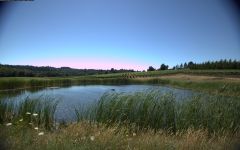Schramsberg Reserve Brut 2007
-
Wine
Enthusiast -
Robert
Parker -
Wine
Spectator -
Connoisseurs'
Guide


Product Details
Your Rating
Somm Note
Winemaker Notes
The Reserve is well-suited with a main course, such as fruit-stuffed veal, pork tenderloin, roasted duck with mango, cedar-plank grilled salmon and curried chicken salad. This flavorful bubbly can also be served as an apéritif with smoked oysters, caviar and hard cheeses such as aged Swiss Sbrinz, Sonoma Vella Jack or Irish Coolea.
Blend: 76% Pinot Noir, 24% Chardonnay
Professional Ratings
-
Wine Enthusiast
Made from 76% Pinot Noir and 24% Chardonnay, spice-tinged fruit aromas and toasted baguette complexity make a grand entrance on the nose. It then gushes bold and complex flavors, like toasted walnuts and almonds, poached pears and a touch of ginger. Although big and broad in flavor for a sparkling wine, it's very well structured and a good bet to age through 2022 or longer. Cellar Selection
-
Robert Parker's Wine Advocate
Another stunner is the 2007 Reserve sparkling white, which is 76% Pinot Noir and 24% Chardonnay, of which 40% is barrel-fermented. This spent seven years on its lees before disgorging, and it's the Pinot Noir-dominated equivalent of their Chardonnay-dominated cuvée called J. Schram. This is crisp, elegant, shows structure, creamy honeyed richness, beautiful opulence, medium to full body and stunning brioche, honeysuckle and apple marmalade-like notes.
-
Wine Spectator
Polished, plush and full-bodied, with hints of rich maturity. Aromas of yeasty cinnamon brioche, cherry and apple open to layered flavors of hazelnut, crème brûlée and spice.
-
Connoisseurs' Guide
As has been the consistent case in the past, Schramsberg’s Reserve bottling runs to the very yeasty, highly autolyzed side of things, and there is little room for even vestigial fruit among its layers and layers of browned biscuits, vanilla, caramel and soy. It is not particularly elegant, but it is frothy and full of very fine bubbles. While commanding in terms of sheer richness and range, it is starting to show a late inclination to dryness that has us wanting to drink it a bit sooner rather than later.
Other Vintages
2012-
Wine
Enthusiast -
Wilfred
Wong -
The Somm
Journal -
Wine
Spectator -
Connoisseurs'
Guide
-
Wine
Enthusiast -
Connoisseurs'
Guide
-
Wine
Enthusiast -
Robert
Parker -
Wine
Spectator -
James
Suckling
-
Wine
Enthusiast -
Wine
Spectator
-
Wilfred
Wong -
Wine
Enthusiast -
Robert
Parker -
Wine
Spectator
-
Wine
Enthusiast -
Wine
Spectator -
Wine &
Spirits
-
Wine
Enthusiast -
Robert
Parker -
Connoisseurs'
Guide -
Wine
Spectator
-
Wine
Enthusiast -
Connoisseurs'
Guide -
Wine
Spectator
-
Wine
Spectator -
Wine
Enthusiast -
Connoisseurs'
Guide
-
Wine
Enthusiast
-
Wine
Spectator








In 1965, Jack and Jamie Davies founded Schramsberg and set out to make world-class sparkling wine in the true méthode traditionelle style on the property originally established in 1862 by German immigrant Jacob Schram. There were only 22 bonded wineries in Napa Valley and fewer than 100 acres of California vineyards planted to Chardonnay and Pinot Noir. Schramsberg was the first California winery to provide a Blanc de Blancs in 1965 followed by a Blanc de Noirs in 1967. Now their son, Hugh Davies, leads the winery’s management and winemaking team.
The Schramsberg estate in Napa Valley’s famed Diamond Mountain District is a registered historic landmark with Napa’s first caves, hand-dug in the 1880s, and its first hillside vineyards. Quality focus drives all aspects of wine production starting with access to over 120 cool-climate sites in Carneros, Marin, Mendocino and Sonoma, which result in over 200 separate lots. Unique among California sparkling wine houses, Schramsberg ferments about 25 percent of its juice in oak barrels to produce rich, flavorful, complex wines.
Most of Schramsberg’s viticultural and winemaking practices are carried out by hand: grapes are hand harvested, the wines are handcrafted, and the bottles are stacked and riddled in underground caves. The family and the winery embody excellence and innovation in winemaking, as well as preservation of their land, their history and their community.

Representing the topmost expression of a Champagne house, a vintage Champagne is one made from the produce of a single, superior harvest year. Vintage Champagnes account for a mere 5% of total Champagne production and are produced about three times in a decade. Champagne is typically made as a blend of multiple years in order to preserve the house style; these will have non-vintage, or simply, NV on the label. The term, "vintage," as it applies to all wine, simply means a single harvest year.

Reaching up California's coastline and into its valleys north of San Francisco, the North Coast AVA includes six counties: Marin, Solano, Napa, Sonoma, Mendocino and Lake. While Napa and Sonoma enjoy most of the glory, the rest produce no shortage of quality wines in an intriguing and diverse range of styles.
Climbing up the state's rugged coastline, the chilly Marin County, just above the City and most of Sonoma County, as well as Mendocino County on the far north end of the North Coast successfully grow cool-climate varieties like Pinot Noir, Chardonnay and in some spots, Riesling. Inland Lake County, on the other hand, is considerably warmer, and Cabernet Sauvignon, Zinfandel and Sauvignon Blanc produce some impressive wines with affordable price tags.
